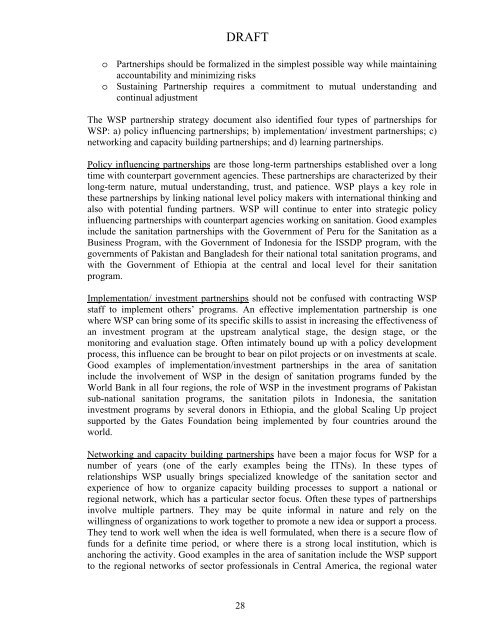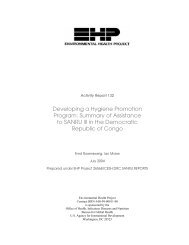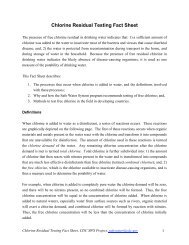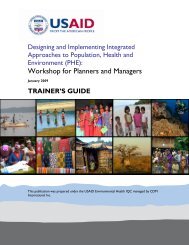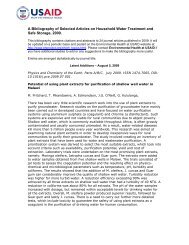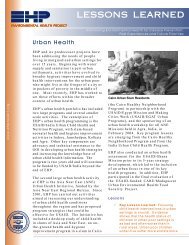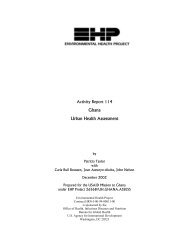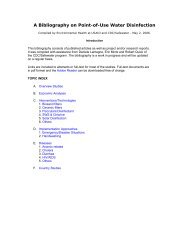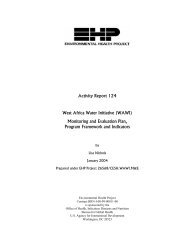The Water and Sanitation Program - Environmental Health at USAID
The Water and Sanitation Program - Environmental Health at USAID
The Water and Sanitation Program - Environmental Health at USAID
Create successful ePaper yourself
Turn your PDF publications into a flip-book with our unique Google optimized e-Paper software.
DRAFTo Partnerships should be formalized in the simplest possible way while maintainingaccountability <strong>and</strong> minimizing riskso Sustaining Partnership requires a commitment to mutual underst<strong>and</strong>ing <strong>and</strong>continual adjustment<strong>The</strong> WSP partnership str<strong>at</strong>egy document also identified four types of partnerships forWSP: a) policy influencing partnerships; b) implement<strong>at</strong>ion/ investment partnerships; c)networking <strong>and</strong> capacity building partnerships; <strong>and</strong> d) learning partnerships.Policy influencing partnerships are those long-term partnerships established over a longtime with counterpart government agencies. <strong>The</strong>se partnerships are characterized by theirlong-term n<strong>at</strong>ure, mutual underst<strong>and</strong>ing, trust, <strong>and</strong> p<strong>at</strong>ience. WSP plays a key role inthese partnerships by linking n<strong>at</strong>ional level policy makers with intern<strong>at</strong>ional thinking <strong>and</strong>also with potential funding partners. WSP will continue to enter into str<strong>at</strong>egic policyinfluencing partnerships with counterpart agencies working on sanit<strong>at</strong>ion. Good examplesinclude the sanit<strong>at</strong>ion partnerships with the Government of Peru for the <strong>Sanit<strong>at</strong>ion</strong> as aBusiness <strong>Program</strong>, with the Government of Indonesia for the ISSDP program, with thegovernments of Pakistan <strong>and</strong> Bangladesh for their n<strong>at</strong>ional total sanit<strong>at</strong>ion programs, <strong>and</strong>with the Government of Ethiopia <strong>at</strong> the central <strong>and</strong> local level for their sanit<strong>at</strong>ionprogram.Implement<strong>at</strong>ion/ investment partnerships should not be confused with contracting WSPstaff to implement others’ programs. An effective implement<strong>at</strong>ion partnership is onewhere WSP can bring some of its specific skills to assist in increasing the effectiveness ofan investment program <strong>at</strong> the upstream analytical stage, the design stage, or themonitoring <strong>and</strong> evalu<strong>at</strong>ion stage. Often intim<strong>at</strong>ely bound up with a policy developmentprocess, this influence can be brought to bear on pilot projects or on investments <strong>at</strong> scale.Good examples of implement<strong>at</strong>ion/investment partnerships in the area of sanit<strong>at</strong>ioninclude the involvement of WSP in the design of sanit<strong>at</strong>ion programs funded by theWorld Bank in all four regions, the role of WSP in the investment programs of Pakistansub-n<strong>at</strong>ional sanit<strong>at</strong>ion programs, the sanit<strong>at</strong>ion pilots in Indonesia, the sanit<strong>at</strong>ioninvestment programs by several donors in Ethiopia, <strong>and</strong> the global Scaling Up projectsupported by the G<strong>at</strong>es Found<strong>at</strong>ion being implemented by four countries around theworld.Networking <strong>and</strong> capacity building partnerships have been a major focus for WSP for anumber of years (one of the early examples being the ITNs). In these types ofrel<strong>at</strong>ionships WSP usually brings specialized knowledge of the sanit<strong>at</strong>ion sector <strong>and</strong>experience of how to organize capacity building processes to support a n<strong>at</strong>ional orregional network, which has a particular sector focus. Often these types of partnershipsinvolve multiple partners. <strong>The</strong>y may be quite informal in n<strong>at</strong>ure <strong>and</strong> rely on thewillingness of organiz<strong>at</strong>ions to work together to promote a new idea or support a process.<strong>The</strong>y tend to work well when the idea is well formul<strong>at</strong>ed, when there is a secure flow offunds for a definite time period, or where there is a strong local institution, which isanchoring the activity. Good examples in the area of sanit<strong>at</strong>ion include the WSP supportto the regional networks of sector professionals in Central America, the regional w<strong>at</strong>er28


